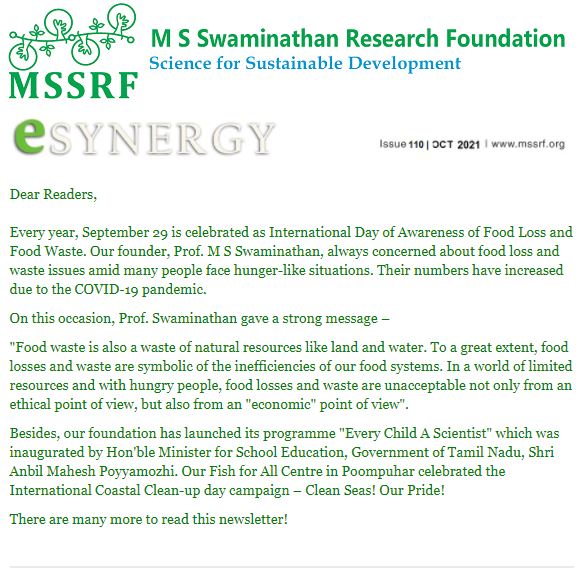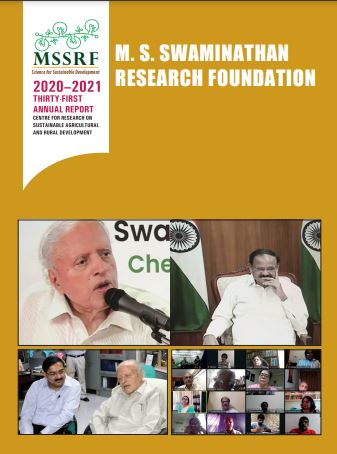A situation assessment & recommendations
1. Overview:
Freshwater aquaculture contributes to over 95 per cent of the total aquaculture production and comprises carp fishes, catfishes (air breathing and non-air breathing), freshwater prawns, pangasius, and tilapia.
India houses 10 per cent of the global diversity in fish and is the second largest producer in aquaculture. Freshwater aquaculture contributes to over 95 per cent of the total aquaculture production and comprises carp fishes, catfishes (air breathing and non-air breathing), freshwater prawns, pangasius, and tilapia. In addition, brackishwater aquaculture comprises culture of shrimp varieties mainly, the native giant tiger prawn (Penaeus monodon) and exotic whiteleg shrimp (Litopenaeusvannamei). The production of carp in freshwater and shrimps in brackishwater forms the bulk of aquaculture activity
Brackish water aquaculture in the coastal areas is an important source of livelihood for coastal communities. Andhra Pradesh led with production of 4.59 lakh tonnes of shrimpwhile national export stood at 6.9 lakh tonnes in 2017-18. Shrimp farming is undertaken by small, medium and large-scale farmers.
Most of the freshwater fish culture activities in India could be considered as rural aquaculture by families. Fish culture in village tanks and farm ponds follow the improved traditional or semi-intensive composite culture/ polyculture system and they serve the household’s consumption needs and as a source of additional income for the farm family.
Both freshwater and brackish water fish farmers have been severely affected by the Covid19 lockdown
2. COVID impact
2.1.Brackishwater Aqua farmers:
- Small aqua farmers especially in Krishna district of Andhra Pradesh and also in other parts of the east coast of India earn their livelihood through a combination of agriculture, fishing and aquaculture. These small farmers procure inputs like shrimp feed and diesel for pumping water from the earnings through fishing or agriculture /labour. With both fishing and agriculture work stopped due to the lockdown around COVID-19, they are facing financial constraints to procure these inputs. They are using low quality feed which will retard shrimp growth. Some of the farmers are not harvesting due to lack of market; as a result, they spending more money on feed to maintain the stocked shrimp in the ponds.
- Many aqua farmers stocked shrimp in their ponds from January and the culture is in different stages. Generally, farmers harvest shrimp based on factors like maturity (30 – 40 g size), expected environmental hazards such as floods and cyclones, and outbreak of disease. Shrimp culture is highly susceptible to disease outbreak, and farmers generally harvest shrimps immediately after the outbreak if the size is about 10 grams, to minimise loss. However, now because of the lockdown, labour is not available for harvesting; even a delay of one day can lead to loss of the entire culture, causing massive financial distress.
- Disease outbreak can spread to the entire area within a short period and it will be difficult to manage as the produce is highly perishable. Harvesting and processing huge quantities without transport facility and in the face of labour shortage is very difficult and farmers are facing the brunt of this.
- There is also shortage of feed and other chemicals required for culture due to lockdown. Shrimp is cannibalistic and if sufficient feed is not given, they tend to kill and eat juveniles/ moulted /weak animals.
- Aqua farmers use thrash fishes particularly low quality dry fishes, for crab / fish culture. As fishing has been suspended for more than 15 days there is a scarcity of dry fish and demand has increased the dry fish price.
- The farmers harvesting the shrimps are not able to sell them as buyers are not coming forward even though the government has fixed the price and given instructions for procurement. With buyers not procuring, farmers have now started selling shrimp at lower price in the local market.
- The shrimp processing industries are processing lower quantities as they cannot store the processed material for long; there is uncertainty for export as most of importing countries are also severely affected. Smaller size shrimps (10-15 g size) are being exported while the larger shrimps (30 – 40 g size) could not be exported at this moment.
- Transport of labourers to shrimp farms has been affected with many villages having blocked the roads for vehicle movement.This together with police patrolling, many labourers are not able to go for work.
- The prices of fish, shrimp and mud crabs have fallen sharply. Earlier, mud crab weighing above 750 g would fetch INR 1,200 per kg;it is now being sold for INR 300. Sea bass which normally sold for INR 500 per kg is being sold for INR 250 per kg. The farmers are harvesting shrimp and selling them in local markets. The non-availability of thrash fishes in villages has become a serious issue for small-scale aquaculture farmers as they use them as feed for culturing fish and crab. The big farmers have just stocked shrimp and if the lockdown continues for more than two months, then there will be a huge crisis for export of shrimps.
- China is importing small size shrimps (10-15 g size); the European and US markets which prefer 30 – 40 g size shrimpsare currently closed. The prices of fish, shrimp and mud crabs have fallen sharply. Earlier, mud crab weighing above 750 g would fetch INR 1,200;it is now being sold for INR 300. Sea bass which normally sold for INR 500 per kg is being sold for INR 250 per kg
2.2 Inland aquaculture
Many inland fish farmers in and around Sirkazhi and Sembanarkovil block in Nagapattinam district of Tamil Nadu had stocked fish in September 2019 and harvest was planned for end March/early April. Harvest has been severely affected due to non-availability of labour and vehicle transport, following the lockdown. This has resulted in partial harvest and some sale just in nearby areas
3. Transport, inputs and labour issues
- Normally, local fish traders come to the fish farm to collect harvested fish. Due to the lockdown, traders’ vehicles are not being allowed at the village level. Even though the government of Tamil Nadu has permitted this, fish farmers at the time of the assessment shared that it is not implemented effectively at the village level. Due to the lockdown, the supply chain of fish farming related activities including fertilizer input, seed and feed has collapsed. Low supply chain of fish feed (rice bran, oil cakes and pellets) has resulted in higher demand and increased price.
- There is non-availability of mechanics for repair and maintenanceofengines at fish farms, due to closure of shops for spares and unavailability of mechanics.
- Diesel supply at specified timings in diesel bunks has increased demand among vehicles and made it difficult to obtain them for farm engines. Fish farmers shared that there are instances of theft of diesel from the farms and farm engines at some places.
- Non-availability of JCBs for renovation and digging of new fish ponds is another issue. Even if farmers manage to get a JCB, labour and hiring charges are higher.
- Farmers are facing a huge labour problem due to high restrictions for movement of people in the village and districts. Even if they manage to get labour, the labour charges are double the usual rates.
- In Odisha, the price of fishes like rohu andmirgal has seen a drastic fall.

Farmers’ voices
Fish farmer from Thennampattinam village in Nagapattinam district, Mr. Gunasekaran, says: “Due to COVID-19 lockdown, all fish farmers are severely affected. We suffered both economically and psychologically. The lockdown completely sealed villages and restricted the movement of people, affecting fish farm activities severely. This is the fish harvesting period and it is very difficult for us to harvest fish without labourers and transport and necessity of feeding the fishes in the ponds. Our humble request to the government is to provide fingerlings and feed free of cost and provide loan up to one lakh without interest. We also need transportation facilities to move the fish to the markets.
Small scale aquafarmer KollatiDhananjey Rao, Sorlagondi village in Nagayalanka Mandal, Krishna District, Andhra Pradesh says “Aquafarmers are in deep crisis as many are in debt due to repeated failure of shrimp culture. They have invested entire earnings and borrowed money from moneylenders. Now, there are no buyers and prices have come down and they do not know what to do. They will lose confidence if there is no procurement of shrimps as per government guideline prices. Many farmers like me may leave shrimp farming in future and the impact will be very severe if the lockdown continues for some more time and people may starve due to lack of income.
MSSRF Support:
At the field level, MSSRF took on several initiatives to support the aqua and fish farmers. IEC materials on Dos and Don’ts under COVID situation in fish farming were developed widely and communicated to fish farmers in around MSSRF working sites
- Identified local fish traders and facilitated fish farmers to sell harvested fishes
- Helped address farmers’ queries related to fish farming and marketing through whatsapp and audio conferencing
- Phone in programswere arranged for fish farmers to get advisories related to fish farming and clear their doubts with expert guidance
- COVID-19 awareness was disseminated through voice SMS, while emphasizing on physical distancing during fish farming and harvesting
Recommendations:
It is expected that the exemption of shrimp and fish farming from the lockdown as per the guidelines of the Ministry of Home Affairs, Government of India on 15 April, 2020 will help address the concerns of fish farmers. Dissemination of information and effective implementation of guidelines have to be ensured. The following are recommendations based on the situation assessment.
- Procurement of shrimp as per government fixed prices needs to be monitored and implemented. The Andhra Pradesh government for instance has announced prices;other governments also should announce similar schemes to procure them.
- Relaxation in transportation to market produce immediately after the harvest in the nearby towns and also allowing labourers to travel and work in the farms.
- Exploring options and promotion of shrimp sales in the Indian markets rather than looking at international markets; even after lockdown, many countries may likely not import shrimps and it is time to increase quality supply to Indian consumers.
- Insurance policy needs to be reassessed. It is very difficult to get insurance coverage as per existing schemes for shrimp farming and the premium is also high. A viable insurance cover should be provided for these small farmers.
- Increasing cold storage facility in major hubs and also processing plants to meet these disasters in future. With the support of NFDB the state fisheries department should establish mega cold storage facilities in major aquaculture hubs to store the fishes/ shrimps for considerable time.
- Immediate arrangements should be made from the Government procurement centre for procuring freshwater catch.
- Ensure transport facility to connect the supply chain of the products ensuring smooth flow, without any restrictions.
- Provide arrangements to issue fish fingerlings and seeds for the farms free of cost.
- A separate supply timethrough token systems could be arranged for diesel supply for the farm activities to prevent crowding and also to ensure it is streamlined.
Prof M S Swaminathan: “Small scale aquaculture requires considerable attention in three areas: pricing, marketing and organisation. Many of these are long-term needs, but there are a few issues that are immediate, and related to corona. Right now we need to focus on the problems arising due to corona, as money is pouring in for corona, rather than for resolving the ongoing problems of small scale aqua farmers.”
Credits
Design and Web: K Dileep, R Srinivasan Coordination & Editing: R V Bhavani, B Jayashree, Content: S Velvizhi Contributors: Deepak Ramaiyan, D Suvitha, E Thamilzhazhagan , N Veerabhadra Rao, J Arockia Kevikumar, A Mubarak Ali, E Selvaganapathy, Akshaya K Panda
Print Version :COVID Policy Brief – Aquaculture

